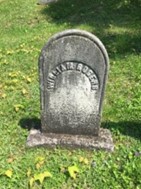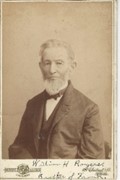

William H. Rogers Sr., son of Joseph (Steven) Rogers and Sarah Hazard, was born on May 7, 1754 in Richmond, Rhode Island.
He married Ruth Hayward (1753-1877) on September 29, 1774 in Lebanon, Tolland County, Connecticut. Their daughter, Lucy Rogers, married Pomeroy Tucker. William was a trustee of the First Baptist Church of Palmyra. He later married Cynthia Dennison Rogers, the widow of his brother, James Roger, in 1793 in Stonington, Connecticut. They became the parents of five children: James Dyer Rogers, Cynthia Rogers, Sophia Rogers, Hazard Wilcox Rogers, and Prudence Rogers. He then married Louisa A. Greeley and later a woman named Hannah.
In 1796, William sold his land in Richmond, Rhode Island. With his brothers, Thomas II and James Rogers and their families, and his mother, Sarah Hazard Rogers, he journeyed to Palmyra, New York. He was a member of the New York State Assembly, representing Wayne County.[1]
William served the community of Palmyra as an overseer of highways (1796, 1799-1800, 1804, 1814), an overseer of the poor (1797), a justice of the peace (1797, 1806-1808), a poor master (1799), an assessor (1802, 1805), a collector (1805-1806), a supervisor (1807-1808), a school inspector (1813-1815), and a town assessor (1829). William registered to mark his cattle at the Palmyra Town.[2]
In 1804, William granted a deed to Weaver Osband.[3] On March 30, 1808, William was appointed a judge in Ontario County. He later became a magistrate, prominently identified with the history of Palmyra and Ontario County.
William fought in the War of 1812.[4] He was the commandant of a battalion. He fought in the battles of Pultneyville and Sodus on Lake Ontario.[5] On March 19, 1817, William was appointed a judge by the Ontario General Commission.[6]
In 1819, William granted deeds to Hazard Rogers, James Rogers, Jared D. Rogers and John Rogers.[7] He was listed in the 1820 US Federal Census of Palmyra as having a household of one male age 10-16, one male age 45+, one female age 10-16, one female age 16-26, and one female age 45+.
On November 21, 1821, Seymour Scovell built the packet boat “Myron Holley,” the first boat to launch from Palmyra on the Erie Canal. At 11 a.m. on November 21, 1821, a procession began at the Eagle Hotel led by Thomas Rogers II, grand marshal of the occasion. Following a cannon blast, the town band played. Gentlemen requested to give toasts and speeches were seated in the boat. About two hundred Palmyra residents were present to watch the proceedings. As the boat began to sail, there were three cheers and more gun fire. After the boat sailed, about a hundred people gathered in the Eagle Hotel to partake of an elegant supper prepared by Major William Rogers.[8]
When the 116 manuscript pages were stolen, William was age seventy-four.
In 1834, he was appointed Overseer of Highways for District 5.[9] On January 14, 1835, E. B. Grandin wrote the following with reference to William’s death: “At tannery in morning—in afternoon went down home and was present at the death of William Rogers senior, aged 82 years. Weather mild.”[10] On January 15, 1835, E. B. Grandin wrote, “Attended funeral of William Rogers senior.”[11] In 1862, the widow of William H. Rogers died in Williamson, New York.[12]
[1] “Death of Maj. William Rogers,” Durfee Scrapbook No. 2, 1864–1875.
[2] Old Palmyra Town Records.
[3] Ontario County, NY Grantee Deed Index, 1789–1845.
[4] Palmyra Cemetery Records.
[5] “Death of Maj. William Rogers,” Durfee Scrapbook No. 2, 1864–1875.
[6] “Appointment by the Council,” Geneva Gazette, March 19, 1817.
[7] Ontario County, NY Grantee Deed Index, 1789–1845.
[8] “The Launch,” Western Farmer, November 21, 1821.
[9] 1834 Minutes of Palmyra Town.
[10] Egbert B. Grandin Diary, 1831–1841.
[11] Egbert B. Grandin Diary, 1831–1841.
[12] Durfee Scrapbook No. 1, 1831–1863.
